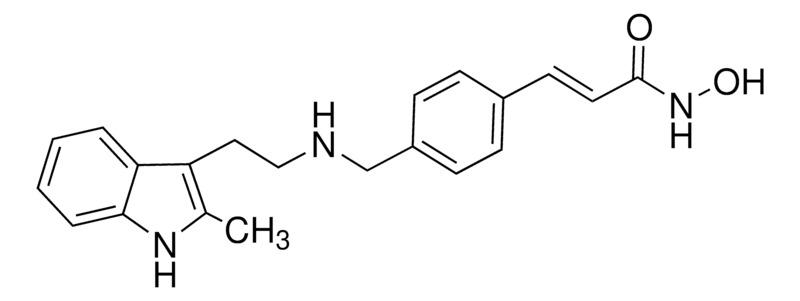Specifications:
| Application | molecular biology | ||
| Storage Temperature | -20°C | ||
| Product Type | Enzymes | Forms | Solid |
| Product Brand | Selleckchem | ||
| Product Grade | Analytical grade | Formula | C21H23N3O2 |
Broad-Spectrum Histone Deacetylase (HDAC) Inhibitor with Potent Antitumor and Latency-Reversing Properties
Panobinostat (LBH589, NVP-LBH589) is a novel, potent, and broad-spectrum HDAC inhibitor with an IC₅₀ of 5 nM in cell-free assays. It effectively inhibits HDAC activity in MOLT-4 T-cell leukemia cells (IC₅₀ = 5 nM) and Reh pre-B leukemia cells (IC₅₀ = 20 nM). As a Phase 3 clinical candidate, Panobinostat exhibits pro-apoptotic and autophagy-inducing effects, disrupts HIV-1 latency, and shows broad-spectrum antitumor activity, especially in hematologic malignancies and small cell lung cancer (SCLC) models.
Mechanism of Action
Panobinostat functions as a tight-binding HDAC inhibitor, promoting acetylation of histone proteins and non-histone targets, leading to cell cycle arrest, apoptosis, and transcriptional modulation of oncogenic and DNA repair pathways.
In Vitro Activity
- Targets: HDACs in MOLT-4 and Reh cell lines
-
Activity:
- IC₅₀ = 5 nM (MOLT-4)
- IC₅₀ = 20 nM (Reh)
-
Effects:
- Induces apoptosis and G2/M arrest
- Increases histone H3/H4 acetylation (H3K9ac, H4K8ac, etc.)
- Upregulates p21 and downregulates c-Myc
- Elevates DNA repair and pro-apoptotic gene expression
- Inhibits cell proliferation across multiple cancer cell lines (e.g., NSCLC, SCLC, mesothelioma)
Cell Research Protocol
| Cell Lines | MOLT-4 (T-cells), Reh (pre-B cells) |
|---|---|
| Concentration | 50 nM |
| Incubation | 48 hours |
| Assay | Annexin V/PI staining followed by flow cytometry |
| Outcome | Increased apoptosis and decreased cell viability |
In Vivo Efficacy
Panobinostat exhibits significant tumor suppression in vivo:
- Model: SCID mice xenografted with lung cancer or mesothelioma cells
- Dose: 20 mg/kg (i.p.), 5 days/week
-
Results:
- Up to 81% tumor volume reduction (BK-T, RG-1, H69)
- Particularly effective against small cell lung cancer (SCLC) models
- Comparable efficacy in immunocompetent and immunodeficient mice
- Minimal tumor regression in NSCLC under similar dosing
Molecular Targets & Biomarkers (from in vitro studies)
- Histone Marks: H3K9ac, H3K18ac, H4K8ac, H4K16ac
- Cell Cycle & Apoptosis: p21, p27, cleaved PARP, cleaved caspase-3, caspase-8
- Transcription Factors: c-Myc, IRF4, Sp1
- Epigenetic Regulators: DNMT1, EZH2
- Others: RAD51, BRCA1, CHK1, Synaptophysin, NeuroD1
Experimental References
-
PMIDs:
- 31071955 (Western blot analysis)
- 23544167 (Immunofluorescence)
- 27738323 (Growth inhibition assay)
Applications
Epigenetic Therapy Research – HDAC inhibition, chromatin remodeling
Cancer Pharmacology – Leukemia, SCLC, NSCLC, mesothelioma, neuroblastoma
Latency-Reversing Agents – HIV reservoir disruption studies
Cell Cycle & Apoptosis Research – p21, c-Myc, caspase pathways
DNA Repair Pathway Modulation – BRCA1, RAD51, CHK1 expression analysis
- Pack Size: 10mg 50mg 1g 10 mM x 1 mL in DMSO 200mg




 0
0
